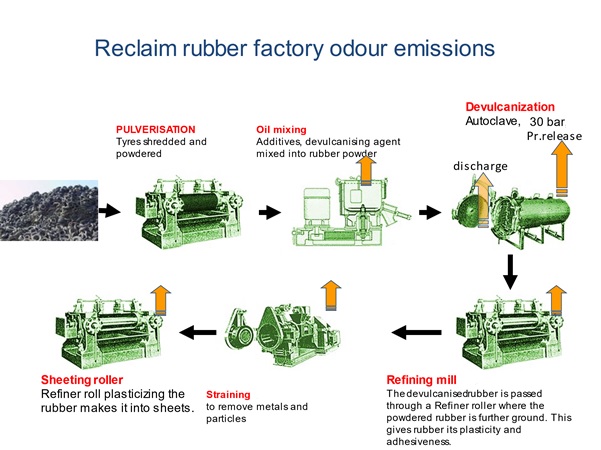
Odour emission from industrial and commercial establishment invariably attracts adverse public attention. Regulatory agencies have closed down industries because of odour complaints. Odour also affects worker health and labour relations. Until the development of gas biofilters, odour control system was expensive and inefficient.
Rubber reclaiming refers to the process of reclaiming rubber from scrap tyres. Tyres are ground to small particles and subjected to devulcanizing. After devulcanizing the rubber is soft and can be compounded with additives and rolled into sheets that can be used as a raw material in the manufacture of new tyres. Chemical reclaiming uses devulcanizing chemicals and high temperature and pressure (20-22 bar) to soften ground rubber. These chemicals are aromatic organic compounds. The reaction is carried out in autoclave as batches. At the end of the reaction, the devulcanized mash is discharged after autoclave pressure is released.
The autoclave pressure release contains a large amount of volatile organic compounds. Many of these are sulphur containing organic compounds formed from devulcanizing of rubber, which is essentially breaking of sulphur cross-linkages in vulcanized rubber. If condensed, the condensates from autoclave steam release, is extremely foul smelling and hence is an effluent discharge issue. The soft rubber mash discharged from autoclave is hot and is a source of odourous vapours. Another source is the handling and working of rubber during maceration and sheeting.

Figure 1: The orange upward arrow shows odour emission sources
Hot autoclave release emissions are treated separately by direct incineration in the factory boiler. Scientifically calculated and automatically controlled release of vapour ensures complete combustion while boiler firebox temperatures are unaffected. The incineration system not only destroys odour but also eliminates effluent. The remaining low strength, low temperature vapour is better treated in the Biofiltration unit.
Biofiltration uses micro-organisms to remove undesirable components from industrial waste gases. Waste gases are forced through filter material on which micro-organisms are immobilised. After absorption in the filter material, micro-organisms break down the polluting components and transform them into harmless products such as carbon dioxide, mineral salts or acids and water. Biological waste air treatment processes offer a cost-effective solution for the treatment of large volumetric airstreams containing low levels of pollutants. They have found use in a broad spectrum of industries. Biofiltration is distinguished by its low operating costs, low maintenance requirements and low energy requirements. Properly designed biofilter achieve very high odorant removal efficiency (>99%).
Biofilters can be designed as low-cost open systems with single stage media. Where land is not available, biofilters can be provided as multi-storey units. Biofilters can also be located on roof of factory buildings to have maximum space savings.
EES undertakes careful study of customer requirements before design of the odour control system. The most important step in the design of a successful odour control system is that characterisation and estimation of quantity of odour emissions. In most cases, direct measurement of quantity of emissions is impossible. It requires considerable skill and creativity to make reasonable estimates required for design.
Pre-treatment requirements and media composition have to be selected to suit the emission characteristics. Hot gases have to be cooled and humidified before biofiltration. Elixir Enviro Systems Pvt Ltd (www.elixirenviro.in) designs the ventilation system required to collect odour from open spaces like dumps or sumps and closed spaces such as sheds. Gas biofilter are best suited for emissions with low VOC concentration. For high strength emissions such as pressure reactor release, EES designs incineration system for odour control.
EES is biofilter media is advanced proprietary development originally based on license from the patented biofilter media of CSIR-NIIST. The media marketed by EES is known for its high-performance, low-cost BIOFILTER MEDIA. It features
Guaranteed performance and life
very low pressure drop,
Plug and play start-up to maximum activity,
high water holding capacity
green eco-friendly material
This biofilter media has the ability to accommodate highly varying “puff” loads which is a common occurrence from may industrial sources.
Bacteria are at the heart of a successful biofilter and a key factor is the growth of suitable microbial population. EES (www.elixirenviro) brings experience of Odour Control system in different fields and internationally recognized competence in biological treatment systems to guarantee biofilter performance.




